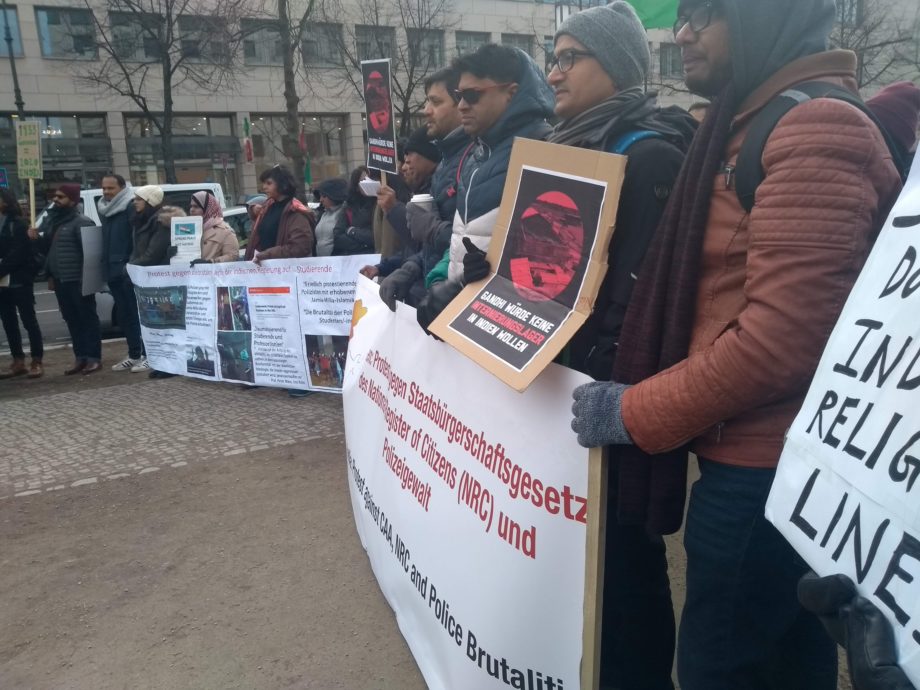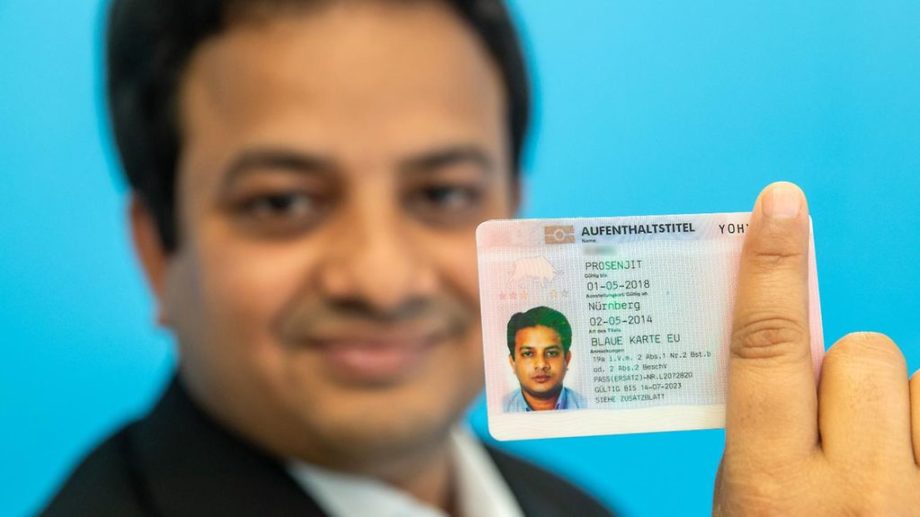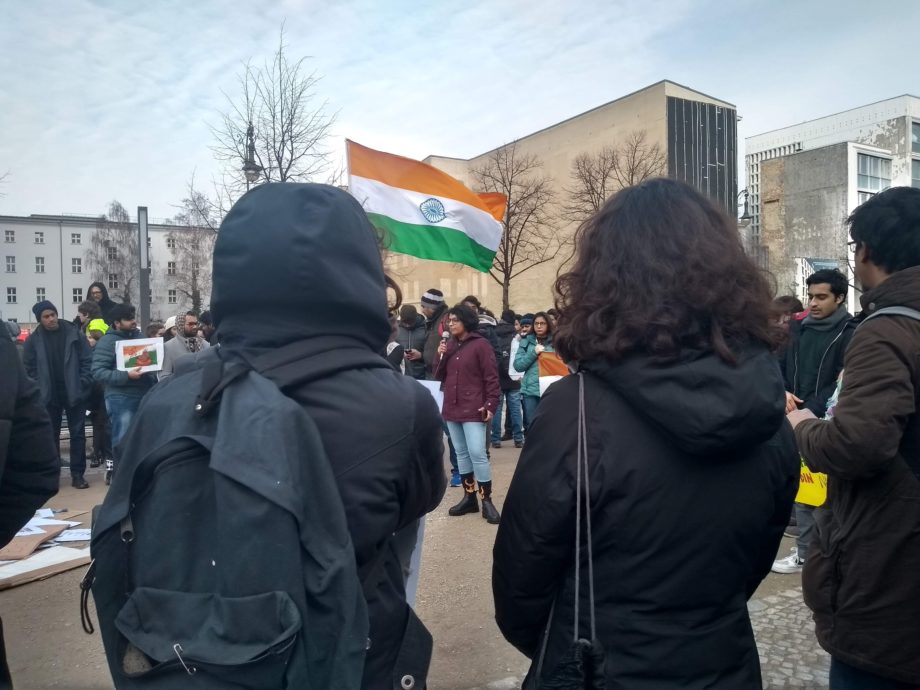Does COVID-19 facilitate new migration?
Exploring a fast-expanding Indian diaspora in Germany

Young Indian white collar migrants are protesting at the Brandenbuerger Toer in Berlin against the impending citizenship amendment bill to be imposed by the Government of India. Date: December, 2019. Source: Amrita Datta
Mobility and the Coronavirus
The coronavirus has impacted mobility in more ways than just one. On the one hand, international mobility has almost come to a standstill due to national lockdowns and restrictions on airplanes and long-distance trains. On the other hand, forced migration during the pandemic has brought forth devastating effects in the lives of thousands of wage labourers in countries like India where return movements of labourers in bulks from cities to their villages triggered a series of life challenges for them – unemployment, poverty, malnutrition etc. In a word, COVID-19 has impacted mobility in all its forms; from that standpoint, mobility has emerged as the most contested terrains during this pandemic, ranging from forced return migration of African migrants from Gulf countries to the immobility capital (Biao, 2020) for some. At the same time, while COVID has restricted mobility at large, it is also creating new opportunities of migration. In this essay, we are interested in those new opportunities of migration that COVID-19 is envisaged to create.
So the larger question is – how does COVID-19 accelerate existing migration pathways and how does it create new migration? In this essay, I will answer this question based on a recent research[1] project I conducted on the Indian migrants in Germany. This research is a part of the larger project I am conducting at the University of Cologne on the transnational practices of Indian women migrants in Germany, and a webinar series I am moderating on COVID-mobility interface hosted by the Global South Studies Centre, University of Cologne and supported by the DAAD.
Indian Migrants in Germany: What facilitates, what impedes them?
Indian communities in Germany are a relatively small but steadily increasing group of people. Although people have migrated from India to Germany roughly in four phases from 1950s until today, the fourth and the current phase is relevant here. This phase began in 2000 with the introduction of the Green Card Scheme initiated by the German government (discontinued in 2005) followed by the EU Blue Card Scheme in 2016 – bringing young high-skilled technical professionals from India to German cities. Among all EU member countries, Germany has accepted the maximum number of technical migrants from India and China who since then arrive with the Blue Card or receive one on arrival (Faist et al., 2017). Moreover, English language programs offered by German universities are growing in popularity among Indian students eager to pursue higher education abroad. Consequently, Germany has been witnessing a sharp and steady increase in the number of migrants from India, especially young populations with about 36% of it comprising of women (DeStatis, 2019). In that light, increasing popularity of the EU Blue Card and decreasing popularity of the USA as a destination for the Indians has been the pre-COVID factors enabling Indians to continue migrating to Germany for employment and higher education. On the other hand, the overall pre-COVID socio-political and economic situation in India has been a driving factor for outer migration too. From that standpoint, both positive and negative reinforcements have accelerated the migration of Indians to Germany since the introduction of the Blue Card scheme. However, factors like poor health care facilities in India, rising unemployment, lack of political freedom, and increasing cases of violence against women (Himabindu et al., 2014) have accelerated the propensity of emigration multiple times in the past five years. As maintained by Thomas Faist et al. (2017), growing discontent among the youth over the shrinking of democratic spaces and freedom of expression in India has remained a key factor for increasing percentage of Indians in the overall migration demographic in Germany. Coupled with these, public healthcare failure during COVID-19 has emerged as a major push factor for young Indians to migrate to countries with better healthcare facilities, employment opportunities and wellbeing. Germany stands tall in all these cases, especially with reference to the way the public healthcare system in the country has managed to address the coronavirus pandemic.
Expanding Indian Diaspora in Germany: COVID as a key factor

A typical Blue Card Holder in Germany from India – Young, Male, Urban. He is holding the card with a smile on his face – indicates that he is content and happy with his current status as a Blue Card Holder in Germany. Source: bundesregierung.de
From that standpoint, it emerges that growing numbers of Indians are planning to stay back in Germany and build a “home[2]” while a significant percentage of Indians planning to migrate are choosing Germany as their destination. This way, COVID-19 could serve as an accelerator for existing migration pattern and as a game changer for creating new migration. To substantiate this claim, let me now shortly discuss the small research project I conducted with Indian migrants who a) already reside in Germany and b) are planning to migrate to Germany. However, it is essential to note at this point that the profiles of those Indians in Germany and those planning to migrate to Germany are almost exclusively white collar migrants and students for higher education. Therefore, in this essay, their cases are not comparable with those of blue collar migrants coming to Germany from other countries – their experience and pathways of migration could be entirely different from my informants’.
To explore if COVID-19 creates new migration opportunities for Indian white collar workers and students in Germany, I interviewed 40 Indians in Germany out of which 20 respondents identified as women and the rest of the 20 respondents identified as men. Coupled with them, I interviewed 40 Indians in India planning to migrate to Germany of which, again, 20 respondents identified as women and the rest as men. I chose the sample through snowball sampling as I am already oriented with the Indian diaspora in Germany because of my ethnographic project mentioned earlier. Due to intermittent lockdowns, I have not been able to conduct in-person interviews. I sent structured questionnaires with open and close ended questions to my respondents via email and they returned their filled in questionnaire for analysis. For the Indians in Germany, my questionnaire included questions like:
For how long have you been living in Germany?
Who else live(s) with you there?
What is your (and your partner’s etc.) employment situation in Germany?
Could you please explain in few sentences your experience during the lockdown situation especially with reference to:
health protocol to access COVID tests and treatment if needed,
social distancing protocols explained by the government,
self-isolation and quarantine mechanisms,
accessing essential and non-essential items during this period,
socializing protocols,
work from home issues,
reorganizing house work between partners,
childcare and Kita situation (in case you have children or know of others‘ cases with children),
informal support system from other Indian migrants in Berlin/Cologne/Munich/Frankfurt/Dusseldorf/Stuttgart/Bonn,
Does the COVID experience so far in Germany impact your overall decision to continue to stay in the country or get back to India?
Did you feel vulnerable or discriminated against as a migrant in Germany during COVID-19?
What were the challenges you faced in Germany due to lock down and pandemic during this period?
– to name a few. On the other hand, for the Indians planning to migrate to Germany with jobs, for higher education or to seek employment, the questions included:
What is your motivation to migrate to Germany?
Do you want to live there for long or would like to return to India after few years?
Do you have future plans in Germany?
Are you migrating alone or with family?
Why do you want to migrate from India?
Why are you choosing Germany over other countries like the USA, the UK?
Indian Diaspora in Germany: What does the future hold for them?
The most important questions emerging from this research are: What kind of future do the Indian communities envisage for themselves in Germany? Or, do they envisage a future there at all in the first place? As COVID-19 struck, this question had to be posed in the light of the pandemic which eventually brought me to ask my respondents whether the pandemic changed the way they planned for their future in India and how it impacts their life as an Indian migrant in Germany.

Indian women students are protesting against the Indian government’s anti-Muslim witch hunt, at the Brandenbuerger Toer in Berlin. Date: February, 2020, Source: Amrita Datta
Out of twenty Indian migrant women I interviewed, seventeen said that COVID-19 has changed their plan to stay in Germany in a positive manner – that they now planned to stay in Germany, to buy houses and have children. Earlier, they were undecided but the way the German government has handled the pandemic as opposed to how poorly the Indian government is handling it “back home”[3] has enabled them to make a decision in favour of Germany. The Blue Card Holders now want to build a home in their host country. These women had already maintained earlier that they preferred living in Germany because they felt “free” there, unlike in India. As the respondents explained, this perception of freedom stems from the opportunity to make decisions about their own lives independent of the obligations they had within their larger community of origin. As working women living with their partners or as single women, these Indian women migrants found Germany safer than India and the German society less interfering. Being away from their natal families in India for whom marriage for daughters (like any other traditional society) outdoes all other individual choices that daughters would like to make for herself, these women maintain they felt „stifled“ in their own country, unlike in Germany.
Next, coming to the twenty Indian men – now Blue Card Holders and living in Germany for at least two years, all of them wanted to stay in the host society and maintained that they now had long term plans to settle there. Some also planned to have their aging parents migrate to Germany with a long-term visa, especially after witnessing the “worrying health care situation”[4] in India in relation to COVID-19. The majority of the respondents in India said that they prefer Germany over other countries because of the “robust healthcare facilities, healthy gender relations and freedom to choose than in the USA”[5]. Comparing Germany directly with the USA[6], one respondent shared that “the EU Blue Card is the new US Green Card”, and he would prefer Germany to India because of the growing unemployment in the latter country that leaves him with limited choices to advance his career as a software developer.
Conclusion
Responses from both sets of subjects show that the coronavirus is facilitating young Indian migrants in Germany to make long-term plans in their host society, a decision that they may have been contemplating for a while but that was not easy to make in pre-COVID situation. Plans for having children, having elderly parents migrate to one’s current place of residence and work, long-term bank investment plans and investing on immovable property are clear indicators of the intentions of a fast-expanding Indian diaspora in Germany. The answers of my respondents show that they increasingly decide to reterritorialize in their host society. While the EU Blue Card scheme and English language university programs in Germany offered the necessary structure for the young Indian migrants to consider a future there even before COVID-19, the pandemic acted as an eye opener for them to decide on their future in Germany. Consequently, a consistently failing public health infrastructure in India is not just emerging as a push factor for young Indians to migrate to Germany, but it shows potential to open new migration patterns, too. As a result, a staggering growth in the total number of Indians migrating to Germany demonstrates that although the pandemic jeopardises mobility and migration to the disadvantage of many people, it may also propel new migration trends in some cases. The case of a fast expanding Indian diaspora in Germany is one such example.
COVID has already expanded the scopes of digitization with work from home, virtual meetings and so on. In that light, it is likely that a post-COVID scenario will open new scopes of technical professions. With the growing popularity of the Blue Card, it is unlikely that immigration of Indian white collar technical migrants will be thwarted by the coronavirus in Germany; as a matter of fact, as this research shows, it is likely to increase. Considering an increasingly expanding Indian diaspora in Germany, especially dominated by a young population with white collar jobs and higher education in German universities and planning their futures in Germany, it would be interesting to conduct further research on how migration to Germany unfolds in the future, and if the COVID-19 as a pandemic continues to earn a mention in the migrant landscape in Germany as the second generation of the present Indian students and Blue Card Holders exercise their voting rights in twenty years to decide Germany’s future.
First submitted on 23.08.2020, revised version from 15.12.2020.
Author
Amrita Datta is a researcher on migration and transnationalism at University of Cologne. Earlier, she earned a doctoral degree in Sociology from Jawaharlal Nehru University, New Delhi, India. Presently, she is moderating a webinar series titled “Corona Conversations: Mobility in a (post)COVID Future” hosted by the Global South Studies Centre (GSSC), University of Cologne and supported by the DAAD.
#Witnessing Corona
This article was simultaneously published on the Blog Medical Anthropology / Medizinethnologie. Witnessing Corona is a joint blog series by the Blog Medical Anthropology / Medizinethnologie, Curare: Journal of Medical Anthropology, the Global South Studies Center Cologne, and boasblogs.
References
Arjun Appadurai (1996): Modernity at Large: Cultural Dimensions of Globalization, University of Minnesota Press, Minneapolis.
B.L. Himabindu, Radhika Arora and N. S. Prashanth(2014):Whose problem is it anyway? Crimes against women in India, Global Health Action, 7:1, DOI: 10.3402/gha.v7.23718 [last accessed 26.11.2020].
Xiang Biao (2020): The Emerging Business of Mobility (Part I), The Coronavirus and Mobility Forum, https://www.compas.ox.ac.uk/2020/the-emerging-business-of-mobility-part-i/
Footnotes
[1] The outcome of this research is under consideration for publication.
[2] As Arjun Appadurai terms as “construction of an invented homeland” in Modernity at Large (1996)
[3] Quoted from interviews (respondent number 2, 7, 12, 13, 17- from Indians in Germany)
[4] This is quoted from the interview directly, said by respondent number 17 (from Indians in Germany)
[5] Quoting respondent number 11 (from Indians planning to migrate to Germany) here. But majority of the respondents shared this opinion.
[6] Although the USA continues to the most popular destination for Indians (especially high skilled) living abroad (World Migration Report 2020), Germany emerged as a competitor to the USA with growing anti-migrant sentiments in the later due to anti-immigration policies of the Trump government.































